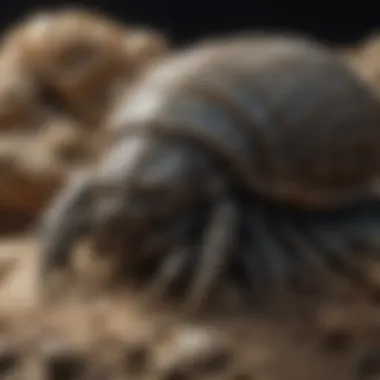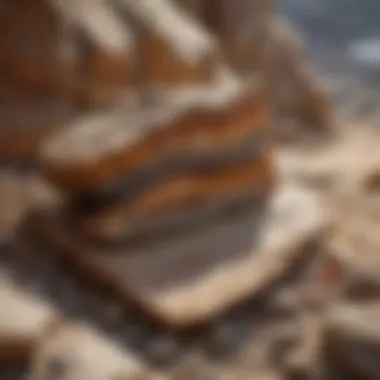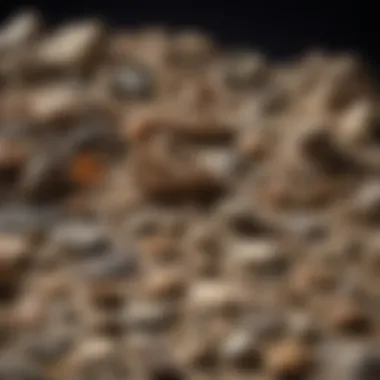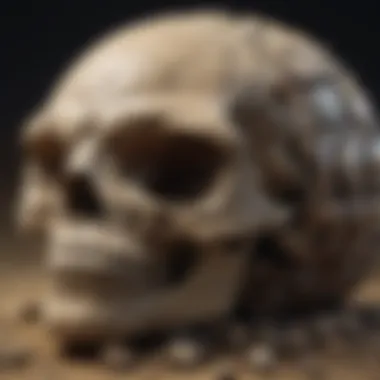A Comprehensive Guide to Fossils: Collecting Geological Treasures


Intro
Fossils hold secrets about our planet's history. Each specimen tells a story of life from ages past, often preserving details about ecosystems that are no longer extant. Understanding fossils is essential for both geological enthusiasts and professionals in the field. This guide aims to breakdown the fascinating world of fossils, explaining their significance and detailing methods for identification, collection, preservation, and display.
Rock and Fossil Identification
Identifying rocks and fossils is a crucial skill for collectors. Successful identification requires attention to details and a knowledgeable approach.
Types of Rocks and Fossils
Rocks can veil fossils within their structure. It is essential to understand the three primary types of rocks:
- Igneous: Formed through cooling and solidifying of magma.
- Sedimentary: Developed from layers of sediment, often containing fossils formed from ancient biological material.
- Metamorphic: Created when existing rocks are transformed due to heat and pressure, though fossils are rarely found here.
Fossils themselves can be categorized as:
- Body Fossils: Remains of the actual organism, such as bones, teeth, or shells.
- Trace Fossils: Indirect evidence of ancient life, including footprints, burrows, or feces (coprolites).
Characteristics to Look For
When examining rocks and fossils, certain traits become pivotal for accurate identification:
- Color: The color can range widely but often indicates the mineral content.
- Texture: Analyze the grain structure, which provides clues to formation processes.
- Striation Patterns: Look for lines and markings, as they can reveal the fossil’s origin and age.
These characteristics inform about the fossil’s whereabouts in geological history.
Tools for Identification
Gather essential tools to improve identification accuracy:
- Hand lens: For close-up examination of small details.
- Field guide: A comprehensive resource tailored for fossils and local geology.
- Notebook: Document observations, sketches, and findings.
Harnessing these tools enhances the efficiency of fossil and rock identification.
Collecting Tips and Techniques
Successfully collecting fossils involves strategy and respect for the environment.
Best Practices for Collecting
- Always seek permission before collecting on private lands.
- Follow local laws and guidelines regarding fossil collection.
- Take care of surrounding areas to leave them undisturbed.
Locating Prime Collecting Sites
Areas rich in fossils often exhibit particular geological features:
- Coastal areas: Erosion reveals fossils along cliffs and beaches.
- Riverbanks: Exposed sediment layers can yield fossils primarily from sedimentary rocks.
- Quarry sites: Often reveal fossil-bearing layers due to excavation.
How to Safely Extract Specimens
To ensure a successful extraction, consider these methods:
- Use appropriate tools: A paintbrush for dusting and a small chisel for careful excavation.
- Work slowly: Patience prevents damaging delicate fossils.
- Wrap specimens gently in cloth or bubble wrap for transport.
Preservation and Display
Proper care is needed to maintain fossil integrity for display.
Techniques for Preserving Rocks and Fossils
Preservation methods vary based on the fossil type and material:
- Use consolidation products for fragile fossils to stabilize structure.
- Store fossils in non-reactive containers to prevent degradation from chemicals.
Proper Storage Methods
- Keep specimens in a stable climate: Avoid extreme temperature and humidity changes.
- Label each fossil with key information: Location, date, and any known details.
Creative Display Ideas
Consider the following display options:
- Shadow boxes: An elegant way to showcase fossils while protecting them.
- Wall mounts: Combine aesthetics with visibility, especially for larger specimens.
Geological Insights
The study of fossils contributes to our understanding of Earth’s sophisticated history.
Geological Formations and Processes
Fossils form through sedimentation, often revealing major geological processes over time. Understanding plate tectonics aids in contextualizing fossil locations globally. Collectors need to link fossil discoveries to these geological processes.
Historical Significance of Rocks and Fossils


Rocks and fossils play pivotal roles in unraveling the timelines of prehistoric ecosystems. Many significant findings have transformed our comprehension of evolution and extinction.
Notable Discoveries in the Field
Crucial excavations have led to landmark discoveries:
- The first dinosaurs in North America changed the study of paleontology dramatically.
- The Burgess Shale discovery unlocked insights into early marine life.
Fulfilling these collecting endeavors requires diligence, with a clear focus on preservation and understanding the time these fossils represent. The journey into fossils reveals unique narratives, enriching not only collections but also geological comprehension.
Prolusion to Fossils
Fossils are essential to our understanding of Earth's history, offering valuable insights into past life forms and environmental conditions. Understanding fossils encompasses a wide range of aspects, including their definition, formation, and significance in the field of geology. In this section, we will explore what fossils are and why they are important, followed by an examination of the fossilization processes that turn organic remains into geological treasures.
Definition and Importance of Fossils
Fossils are the preserved remains or traces of ancient organisms. They can range from bones, shells, and teeth, to footprints and burrows left behind millions of years ago. The significance of fossils lies in their ability to tell stories about the planet's biotic and abiotic history, revealing how life has evolved and adapted over time. Studying fossils aids scientists in reconstructing past ecosystems and tracking significant geological events, such as mass extinctions or climatic changes. Fossils can also help in understanding biodiversity by providing examples of how species once thrived in various environments.
Overview of Fossilization Processes
The fossilization process is complex and requires specific environmental conditions. Not every organism becomes a fossil; several factors determine whether an organism’s remains survive geological time. The main processes of fossilization include burial, sedimentation, and mineralization.
When an organism dies, it often first undergoes burial in sediments. Over time, layers build upon the remains, protecting them from decay and erosion. As sediment compacts, minerals can infiltrate the bones or shells, leading to preservation.
Some key steps in the fossilization process are:
- Death and Burial: An organism dies and is quickly buried by sediments.
- Decay and Sedimentation: The soft tissues may decay, but the hard components are quickly encased in sediments.
- Mineral Replacement: Minerals in groundwater filter through the sediments and replace organic materials, permanently turning them into fossilized remains.
These processes underscore the transient nature of life on Earth and highlight how exceptional circumstances are required for the creation of fossils. Utilizing precise techniques to understand these sequences ultimately enriches our knowledge about Earth's past.
Types of Fossils
Fossils represent vital windows into Earth's past, providing a record of life over millions of years. The types of fossils are essential in understanding biodiversity and evolutionary processes. Each type offers unique insights and serves different roles in both scientific research and collecting. Recognizing these distinctions can enhance one's appreciation for fossils, whether for academic purposes or personal collections.
Body Fossils
Body fossils are the most familiar type of fossil. They include the preserved remains of animals and plants. This category can range from bones, teeth, and shells to leaves and wood. Each specimen captures biological details that reveal how ancient organisms lived, anatomic structures they possessed, and their evolutionary developments over time. For instance, studying dinosaur bones can shed light on their size, diet, and habitat.
Collecting body fossils requires knowledge of geology and paleontology. Key factors to consider include:
- Location: Not all places yield body fossils. Familiarizing oneself with fossil-rich environments increases collection chances.
- Legalities: Many regions have restrictions on fossil collecting. Respecting the law guarantees sustainable practices for future endeavors.
- Condition: The quality and completeness of body fossils can vary. Assessing a fossil's condition is crucial for collectors who value preservation.
Trace Fossils
Trace fossils provide indirect evidence of past life. Unlike body fossils, these do not include actual remains of organisms. Instead, they document activity. Examples include footprints, burrows, and feces. Trace fossils can tell more about behavioral patterns than body fossils sometimes.
Paleontologists analyze trace fossils to reconstruct environmental scenes. The behavioral evidence can reveal:
- Movement patterns of prehistoric creatures
- Interaction between species
- Responses to environmental changes over time
Trace fossils enhance our perceptions of ecosystems, particularly with minimal body fossils found.
Molecular Fossils
Molecular fossils, or biomarkers, represent the remnants of ancient biological materials at a molecular level. They can include organic compounds and isotopic structures derived from organic matter. Unlike conventional fossils, they sometimes form from processes that do not preserve the organism's structure. Instead, they provide chemical fingerprints indicative of ancient organisms.
These fossils are significant for biogeochemistry and evolutionary biology because they can:
- Indicate the presence of specific organisms without direct fossil evidence.
- Track changes in environmental conditions through their molecular make-up.
A key consideration when studying molecular fossils is the required sophisticated techniques for analysis. Advanced methods such as gas chromatography and mass spectrometry are often used to extract and examine these markers carefully.
In collecting fossils, understanding the differences and importance of body, trace, and molecular fossils can greatly enhance one's contributions to the field and personal collection satisfaction.
Whether for scientific inquiries or investment pieces, navigating these types paves the way for richer engagement with Earth's ancient narrative.
The Fossilization Process
Understanding the fossilization process offers vital insights into how fossils form, preserve, and record the history of life on Earth. This process not only explains the transformation of organic material into rock but also sheds light on the environmental conditions necessary for such transformations. Comprehending these elements equips collectors and enthusiasts with a deeper appreciation of their finds, leading to better practices in their pursuit of fossil collecting.
Environmental Conditions
The environmental conditions play a pivotal role in fossilization. These conditions encompass various factors, such as temperature, pressure, and the presence of water or sediments.
Fossils are best preserved in combinations of low oxygen environments, where decomposition is slowed down, and rapid sediment deposition that encapsulates the remains. Marine environments often provide ideal conditions. The fine grains of mud in these settings can encase organic material effectively. This minimizes the exposure of remains to scavengers and atmospheric processes.
Selection of fossil sites often depends on these conditions. Collectors should be aware of regions with historically nutrient-rich waters, as they hold a prospect of diverse fossil finds. Factors that impact fossil development often include not just geological, but also biological activity, creating an intricate interplay that bast ideas.
Stages of Fossilization
The fossilization process consists of several distinct stages, which include death, burial, decay, and ultimately, mineral replacement. Understanding each step is crucial to comprehending how fossils survive through geological time.
Death and Burial


The Death and Burial stage is critical, as it marks the initial transition from a living organism to a preserved relic. Once an organism dies, rapid burial under sediments is essential to protect its remains from decay. This stage’s key characteristic is the urgency of burial; environments such as river deltas and ocean floors frequently suffice.
A notable feature of this stage is that soft-bodied organisms are less likely to become fossils as they decompose before burial. In contrast, hard parts like bones or shells have higher survival chances. While conditions may not always align, cases arise where mass extinction events can abruptly contribute to higher burial rates, leading to rich fossil beds.
Decay and Sedimentation
After burial, the Decay and Sedimentation stage begins, where decomposition continues at slower rates due to anaerobic conditions. During this time, sediment layers stratify, contributing to preservation over millennia. This stage highlights the importance of depth—more sediment generally equates to less oxygen, aiding further preservation. The unique advantage of sedimentation is the consistency of conditions it offers, although not all buried material retreats degradation entirely.
However, one has to note the disadvantage- excessive or quick flux in sediment can cause relocation or destruction of the remains themselves. So the careful balance is essential for safeguarding against the downfall of the biological relics.
Mineral Replacement
Massively significant is the Mineral Replacement stage, wherein organic materials gradually dissolve and are replaced by minerals. This replacement can encapsulate detailed structures of the original organisms. The key characteristic here is that specific minerals, often silica or calcium carbonate, take the place of bio-structures; effectively casting fossils in the elemental response of the earth.
This process showcases one unique advantage: fossils can exhibit articulate details that are otherwise lost in softer decay. However, certain porous materials cannot withstand the pressure or heat during this process, potentially leading to collapse or structural distortion. This balance continues to impress upon collectors the intricate nature of these geological processes.
The fossilization process is a journey from life to stone, demonstrating the earth’s capacity to preserve history and narrate the tale of life long past.
Fossils and Geological Time Scale
Fossils are crucial for understanding the geological time scale. They serve as windows into the past, revealing the environmental conditions and life forms that existed at different times in Earth's history. This place significant role in piecing together the timeline of life on our planet. The geological time scale itself subdivides Earth's 4.5 billion-year history into manageable segments, primarily based on major geological and biological events. These include significant extinctions and geological formations.
Understanding Geological Eras
Geological eras define broad intervals of geological time. The Earth’s history is typically divided into four major eras: the Precambrian, Paleozoic, Mesozoic, and Cenozoic. Each era showcases unique developments in terms of life forms and geological changes.
- Precambrian Era: Spanning nearly 88% of Earth's history, itsup>1sup> encompasses the formation of the planet all the way to the earliest multicellular life. Helpful information comes from studying fossils.sup>2sup> References from layers of rock assist paleontologists in understanding this era.
- Paleozoic Era: This era marks significant changes in both climate and life forms. The Paleozoic is characterized by the Cambrian explosion, which saw a rapid increase in diverse life forms. Fossils from this era are key to understanding early vertebrate development.
- Mesozoic Era: Often referred to as the age of reptiles, this is when dinosaurs ruled the land. The end of this era is marked by a mass extinction event whose cause is still debated. Fossils from this time can help trace the evolution of species, including birds.
- Cenozoic Era: The current geological era, dating from around 66 million years ago to present. Here, mammals became the dominant land animals, reflected in the fossils we study today.
Understanding these eras is essential. It bears implications for paleontological research, ecology, and even climate science. As such, fossils provide the necessary evidence to navigate these geological divisions, helping reconstruct life's evolutionary history.
Fossils as Indicators of Age
Fossils function as valuable indicators of a rock's age. These remains can be used in stratigraphy, particularly biostratigraphy, which uses fossil distributions to make age determinations for a rock layer. Two main concepts play a role:
- Index Fossils: Certain species are known to have existed for a short, well-defined period. Their presence in various rock layers can help establish the relative age of the layers.
- Radiometric Dating: This scientific method analyzes decay rates of isotopes in rocks surrounding fossils, facilitating absolute dating.
Understanding the age of fossils and the rocks that hold them offers significant insights. When combined with the fossil record, it reveals patterns of evolution and extinction episodes over time, painting a clearer picture of Earth's history. This work enriches our knowledge and enhances the scientific community’s comprehension of life's past.
Fossils are like pages of history, each telling a unique story about the organisms that once thrived.
In summary, the correlation between fossils and the geological time scale is imperative for grasping our Earth's history. Each fossil carries critical data essential for understanding evoluti n, environmental shifts, and life's narrative on this planet.
Fossils in Scientific Research
The significance of fossils in scientific research cannot be overstated. These remarkable remnants of past life serve as a crucial link between our current understanding of biology and the ecosystem dynamics of bygone eras. By studying fossils, researchers can glean insights into environmental changes, evolutionary processes, and ancient organisms. This section will provide a ddeep dive into the relevan topics of paleontology and evolutionary studies and their impact on scientific inquiry.
Paleontology and Its Significance
Paleontology acts as a bridge to the past, unraveling the complexities of Earth's history and life forms. Scientists, known as paleontologists, use fossils to understand the conditions that shaped life. This field is significant for several reasons:
- Reconstruction of Historical Ecologies: Fossils allow researchers to reconstruct ancient habitats and ecosystems. Understanding these systems magnificentl helps clarify how species interacted with one another and adapted to diverse environments.
- Insights into Extinction Events: Analyzing fossil records provides context for mass extinction events. This background enables scientists to study patterns and causes of extinction that may also relate to today's biodiversity crisis.
- Climatic Change Studies: Fossils offer a long-term view of climate changes. Studying how organisms reacted to climatic fluctuations helps scientists predict future ecological responses.
Fossils serve as time capsules, transporting researchers to epochs long lost to the sands of time.
Paleontology further contributes to a wide variety of scientific domains ranging from geology to ecology Food webs from ancient osystems are outlined by dissecting the interactions depicted in the fossil record. This intricate understanding brings forward critical knowledge about evolution.
Fossils and Evolutionary Studies
Evolutionary biology sites fossils as critical data points in validating and refining the theory of evolution. The evidence preserved in rocks allows scientists to trace lineage and development of species over millions of years. Notable aspects include:
- Transitional Forms: Fossils illustrate evolutionary transitions between species that did not survive alone in the natural world. For example, the discovery of Archaeopteryx, a feathered dinosaur, is a legendary showcase of the tie between birds and reptiles.
- Phylogenetic Relationships: Fossils provide clues to the phylogenetics or hereditary relationship between organisms. Morphological characteristics inferred from fossilized remains are vital for constructing the tree of life birh.
- Understanding Adaptation: Each fossil tells a story of how a species adapted to its environment. Changes in morphology indicate specific adaptations to survive in diverse habitats, shedding light on the forces of natural selection.
Connecting fossils with the intricate puzzle of evolutionary theory solidifies their role in unraveling life's history. The tireless work of staunch paleontologists continues to mold our comprehension of not before seen relationships and transitions. The impact of this knowledge resonates throughout various scientific fields, ensuring that the study of fossils remains pivotal and relevant to modern discoveries.
Collecting Fossils: A Practical Guide
Collecting fossils is more than just a recreational activity; it is a window into history. For those who engage in this pursuit, understanding practical aspects is crucial. In this guide, we will explore important legal and ethical considerations, the tools needed for successful fossil hunting, and methods for identifying fossil finds. Each of these elements ensures that collectors approach their hobby with both respect for the past and curiosity for the future.
Legal and Ethical Considerations
Legal and ethical aspects of fossil collecting matter greatly. Ignoring legal restrictions can lead to physical confrontations and penalties. Laws vary per state and country; some areas do not allow fossil collection at all. It's advisable to check regulations always before beginning any digging. Some nests of fossils can be legally protected, like national parks or scientific reserves, requiring permission to collect.
Ethics are equally important. Collectors have a responsibility to balance personal interest with the conservation of fossil sites. Disturbing a significant site can lead to the destruction of irreplaceable scientific information. As such, engaging in responsible collecting practices is not only legally mandatory but also a moral imperative.
To ensure the future of fossils for generations to come, vibrant guidelines for responsible collecting should be informed by ethics and legal codes.
Tools for Collecting Fossils
Having appropriate tools can greatly enhance the experience of fossil collecting. Common tools include:
- Hand tools: Hammer, chisel, and trowel. Hammers are especially critical for breaking rock layers, while chisels help in prying fossils loose.
- Safety gear: When collecting, a hard hat, gloves, and safety glasses are important for protection against falling rocks and sharp edges.
- Recording equipment: A notebook or smartphone for documentation is practical. Knowing where and how a fossil was found helps in classification later.
- Fossil guides: Reference books or mobile apps can help in identifying fossils during a trip, providing collectors with immediate insight into their finds.
Finding the right tools not only increases success rates but also minimizes damage to the fossils themselves.


Identifying Fossil Finds
Successfully identifying fossil finds can be rewarding. A novice may overlook key details that can determine whether it’s a genuine fossil. Consider recognizing common types such as:
- Body fossils: Such as bones, teeth, or shells. Pay attention to texture and shape. Often, you will be able to see patterns indicating it was once a living organism.
- Trace fossils: These are indicators of organism activities. Patterns in mud or burrows made by animals can be considered trace fossils.
- Molecular fossils or biomarkers: These may require special biochemical tests to identify. They come from organic materials formed millions of years ago.
As problems of classification arise, a good network of other collectors can aid identification. Community groups, websites, and forums exist to connect like-minded collectors for shared knowledge.
Learning to identify fossil finds with confidence contributes to the overall enjoyment and understanding of the fossil collecting journey. Awareness and passion drive this curiosity, providing connections to ancient organisms in nature.
Preservation Techniques for Fossils
Preservation techniques for fossils are crucial for maintaining their integrity and significance over time. Fossils, being physical representations of past life, often face threats from environmental factors and human actions. Using proper preservation methods ensures that these geological treasures can be studied and appreciated for generations. The benefits of effective fossil preservation include enhancing scientific research, educational outreach, and personal collections.
Cleaning Fossils
Cleaning fossils involves removing unwanted material without damaging the specimen itself. This process usually starts with a careful inspection of the fossil. Each fossil has unique characteristics, which means cleaning methods can vary.
- Gentle brushing: Use a soft brush to remove dirt or dust.
- Water and mild soap: For some fossils, cleaning with water and a tiny bit of mild soap can help.
- Air pressure: Compressed air is effective for small particles that need to be blown away without contact.
- Special tools: Toothpicks or dental tools can be helpful for more delicate work but use them with caution.
Before starting, identify the fossil type. This informs the best cleaning strategy and prevents unintentional damage. For example, fossils that are very fragile may require the utmost care, while harder specimens can handle slightly more abrasive techniques.
Storing Fossils Safely
Storing fossils safely is another key aspect of preservation. If fossils are not stored properly, they may degrade over time. Safe storage protects them from physical damage and environmental influences.
- Use protective cases: Utilize display cases made from UV-protected acrylic to guard against light exposure and dust.
- Avoid moisture: Store fossils in climate-controlled conditions to keep humidity low. Desiccants can absorb excess moisture.
- Soft padding: Place fossils on soft, clean materials like felt or cotton. This reduces the risk of scratches.
- Labeling: Clearly label each specimen with relevant information. This labels can help track your collection and provide context.
In addition to these methods, handling fossils with care is also essential. Always remember to support the piece from its broadest part to avoid chips or fractures. Through appropriate cleaning and storing practices, collectors can ensure that their fossil collections remain intact and informative for years to come.
Effective fossil preservation begins with thoughtful practices in cleaning and safe storage.
The Role of Fossils in Education
Fossils serve as a crucial educational tool across various fields. They provide tangible evidence of life forms that existed in the past. This aspect makes fossils relevant in classrooms, particularly in science education. Students engage with history, biology, and earth science through the study of fossils. They have numerous benefits, fostering critical thinking and analytical skills. These skills are essential for understanding complex scientific concepts.
Fossils in Curriculum
Fossils can be integrated into school curricula at multiple levels. Elementary education often includes basic concepts of fossils. This foundational knowledge sparks curiosity and enthusiasm. Middle and high school curricula can delve deeper. Topics can cover aspects of paleontology, geology, and evolutionary biology. Engaging with fossils stimulates inquiry-driven learning.
Hands-on activities, like fossil excavations, can lead to practical learning experiences. These experiences provide students a first-hand look at geological ages and extinct species. Learning with fossils makes abstract concepts more concrete. This process fosters a connection to our planet’s history. Successful integration can lead to further interest in geology or paleontology as future career pathways.
"Through fossils, students can explore the history of life on Earth, fostering a connection to biology and environmental science."
Promoting Interest in Geology
Fossils significantly promote interest in geology. Exposure to fossils creates natural curiosity about Earth’s past. By studying fossils, students narrate stories of long-extinct creatures. They investigate environmental changes through geological time. Recognizing the relevance of fossils can shift perceptions of geology from a stagnant subject to a dynamic field.
Effective geology education underscores real-life applications. Practical usage may include environmental reconstruction, biodiversity study, and climate change discussions. By connecting fossils with current events, educators can help students realize their study's relevance. Hands-on methods attract not only students but also the wider community.
Ethical Implications of Fossil Collecting
The topic of ethical implications in fossil collecting is essential in understanding the broader impacts collectors have on our planet's historical records. Fossils give us invaluable insights into past life forms and ecosystems. However, the manner in which collectors obtain these artifacts also matters significantly. Serious considerations must be given to ensuring that collecting activities do not harm geological contexts or lead to cultural significant losses.
Balancing Collection and Conservation
When engaging in fossil collecting, a balance between collection and conservation is crucial. Many significant fossils are found within protected areas or public lands. Collecting without permission in these locations can result in both legal consequences and potential loss of vital scientific data. Policies are in place to ensure that fossil resources are available for research and future generations. Responsible collectors respect these regulations and advocate for preservation efforts. They often seek out locations where the risks are minimal.
It is also important for collectors to educate themselves about the geological contexts of where they are hunting. Each fossil provides context that can greatly enhance its value for research. Understanding the ecological implications of extraction can help promote responsible collecting that supports conservation. Here are some key points for collectors to remember:
- Obtain necessary permissions before collecting in designated areas.
- Educate about the legislation covering fossil collecting in their locality.
- Support conservation efforts aimed at protecting significant geological formations.
Collectors should be aware that every fossil they take can impact local geology and paleontology.
Illegal Fossil Trade
Another critical aspect of ethical fossil collecting involves the illegal fossil trade. This underground market often undermines legitimate fossil collection and research. It can lead to the loss of scientifically important specimens that are exported unlawfully. The illegal fossil trade often fuels other illicit activities, and the impact on paleontological integrity can be severe. Collectors involved in illegal activities risk penalties and support a system that threatens scientific integrity.
Awareness is important. Here are some points related to illegal fossil trade:
- Contribute to preservation by discussing and reporting suspected illegal trade activities.
- Research provenance for pieces before purchasing them.
- Educate fellow enthusiasts about the dangers of buying unverified fossils.
Collectors can help protect legitimate collecting as well as promote ethical practices within the hobby through diligence and education. By consciously engaging with the fossil community, individuals can help forge a path where fossil collecting and conservation coexist positively.
Closure
The conclusion serves as a pivotal point in summarizing the insights provided throughout this comprehensive guide to fossils. Its importance lies in distilling complex information into key takeaways that the reader can easily grasp. Reflecting on the significance of understanding fossilization, the diversity of fossil types, and ethical considerations in collecting, it helps reinforce the value of fossils as both scientific treasures and natural artifacts. The unifying narrative brings clarity to the multifaceted subject of fossiology while emphasizing the connection between our past and present.
Summarizing Key Points
In closing, it is essential to recap the prominent themes tackled in this article:
- Definition and Importance of Fossils: Fossils are more than remnants; they encapsulate Earth's history.
- Complex Fossilization Processes: Various conditions lead to fossil formation, revealing clues to different geological eras.
- Types of Fossils: Understanding body, trace, and molecular fossils enriches our knowledge of life forms.
- Scientific Research Significance: Fossils illuminate evolutionary pathways and ecological changes.
- Collecting Responsibly: Ethical considerations and legal stipulations ensure sustainability in fossil collection.
- Preservation Techniques: Proper cleaning and storage practices enhance the longevity of fossil specimens.
- Education and Future Research: Teaching about fossils promotes curiosity, while the scientific community continuously unravels their mysteries.
Future of Fossil Research
The future of fossil research appears promising and innovative. Advances in technology are reshaping the methodologies applied in paleontology. Techniques such as 3D imaging and DNA analysis open new doors to understanding ancient life. Scientists explore the effects of climate change, shedding light on species adaptation across eras. Furthermore, inter-disciplinary collaboration among fields, such as geology, biology, and conservation, fosters comprehensive investigations into our planet's history.
One emerging topic in this domain is the impact of human activity on fossil records. Ongoing studies seek to understand how natural history is being altered by anthropogenic effects. As we forge ahead, educating the public is paramount. Promoting awareness of fossils will inspire upcoming generations to respect natural history and remain engaged in both scientific and conservation efforts.
The journey into the fossil world is not merely academic. It invites responsible stewardship of our planet as past, present, and future intertwine.







